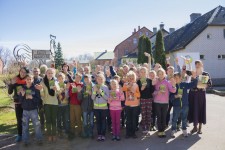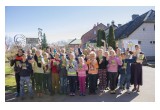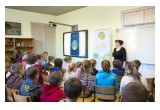
Left behind when their parents left the country in search of employment, a generation of Latvian children were growing up without the traditional values they needed to guide them in life, until a teacher discovered The Way to Happiness and began a campaign to reach her country's youth with this common sense moral code.
Riga, Latvia, August 19, 2016 (Newswire.com) - At the mid-year briefing on the progress of the Scientology-supported humanitarian campaigns, held aboard the Scientology Freewinds religious retreat and replayed last month at every Scientology Church and Mission internationally, Scientologists were briefed on the story of a Latvian teacher who used The Way to Happiness to help the children of her country.
The Way to Happiness is a nonreligious common sense moral code written by author and humanitarian L. Ron Hubbard that can be used by people of any culture or creed to live a happier, more honest and ethical life.
With the economic crisis of 2008, an estimated 10 percent of the Latvian workforce left the country in search of employment. Left behind were thousands of children, deprived of the personal guidance and the positive values their parents would have instilled, resulting in far more truancy and an increase in drug abuse.
Searching for a way to help these children, a teacher discovered The Way to Happiness and realized this could provide the moral compass young Latvians needed to get their lives on track. “I realized this booklet bears great power that could help the Latvian people,” she said.
She teamed up with the head of the Latvian chapter of The Way to Happiness Foundation and they drew up a plan to reach children across the country with the booklet. She pulled together a team of volunteers to help her in her project.
They sent sets of 180 booklets and The Way to Happiness newsletter to every one of Latvia’s 858 schools. They then contacted the principals and teachers and surveyed them on what problems they were encountering and the issues the children were most concerned with. Then they tailored and delivered workshops based on precepts from The Way to Happiness to help them address these situations.
The results of the campaign were profound. In one elementary school, a nine-year-old girl wrote the following after the workshop she attended. “For the first time, I do not think my parents left me. I think they are with me in heart. They are far away because they are trying to solve a financial problem. They did not have a job here and so they had to leave. Because of this, I did not want to write to them and I did not want to think of them. But now I realize that I should do something to support them. I will write and tell them what I have learned today and tell them that I hope they are doing well, and thank them for what they are doing for me.”
When school ended for the summer, the teacher broadened her campaign to encompass the general public. The concept was both simple and effective: a “Thank You” campaign, based on precept 20 of The Way to Happiness—“Try to Treat Others as You Would Want Them to Treat You.” The volunteers invited people to pose for a photo in front of a sign that said “Thank You!” and email the photo to those they wanted to thank. Each was then presented with a copy of The Way to Happiness. People lined up to send messages of thanks to friends, classmates, teachers, mentors, grandparents and parents. In just a few months the volunteers toured some 2,000 miles and helped more than 10,000 people send thank you messages.
Since beginning her campaign two years ago, the teacher and her team of volunteers have given out more than 200,000 copies of The Way to Happiness, reaching some 10 percent of the people of Latvia with its positive message for a better life.
Immensely popular since its first publication in 1981, some 115 million copies of The Way to Happiness have been distributed in 115 languages in 186 nations and the campaign has been embraced by more than 250,000 individuals and groups.
Read the article on the Scientology Newsroom.
Source: ScientologyNews.org
Share:


